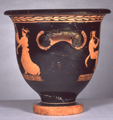| Collection: | Cambridge, Harvard University Art Museums |
| Summary: | Side A: Dionysos with satyr and maenad. Side B: Death of Orpheus. |
| Ware: | Attic Red Figure |
| Painter: | Attributed to the Curti Painter |
| Date: | ca. 440 BC - ca. 430 BC |
| Dimensions: | H. 0.30 m.; Diam. 0.25.2 m. |
| Primary Citation: | |
| Shape: | Bell krater |
| Beazley Number: | 213539 |
| Period: | Classical |
Condition:
Unbroken; minor scratches and abrasions.
Decoration Description:
Side A: Dionysos stands between a seated satyr, playing the double flutes (auloi), and a maenad beating a tympanum, a type of large tambourine. The god stands with his torso and left leg frontal, his right leg in profile to the left, and his head turned toward the maenad at right. He wears an ivy wreath with berries in added white, a himation, and a chiton, the upper half of which is speckled with dots of dilute glaze. His beard is long and pointed, and his long hair falls in ringlets on his shoulders. In his right hand he holds a thyrsos, with white berries among the ivy leaves, and with his left hand pours a libation from a kantharos, the stream of wine rendered in added white. The thyrsos is drawn as though it were a continuous branch, but as ivy does not grow so straight, it may be the usual stalk of fennel with some ivy leaves stuck on the end. The satyr sits with his right leg crossed over the left. His seat is a rock or hummock, drawn with a single line of added white. He is balding, but has curly hair in back; his beard is short and stringy. He wears an ivy wreath like that of Dionysos. The maenad is dancing as she plays the tympanum, which has two rectangular handles on either side, like a bronze laver. She looks down, avoiding the god's eyes, as she steps forward with her right leg. She wears a belted peplos and, around her head, a "fillet" of two snakes mottled with dots of dilute glaze. The white fillet above her head is attached to one of the tympanum handles, so that it whips around as she dances.
Side B: Orpheus is being killed by two Thracian women, who resented the fact that his music so bemused their husbands that they lost interest in their wives. They cut off his head and flung it in the sea, whereupon it floated to Lesbos, singing all the way, and became an oracle. Orpheus falls to the right, but looks back at the woman at left, who plunges a spear into his breast. He is nude except for a fillet and a cloak wrapped around his left arm and over his right shoulder. With his left knee and hand he supports himself on the sketchy groundline, drawn with added white, and with his right hand raises his lyre over his head. The instrument has one too many strings drawn with relief lines — eight — and a sound box made from a tortoiseshell. The maenad at right clutches one arm of the lyre with her left hand, and with the other hand wields a harpé, a short, curved sword like the one Perseus used to decapitate Medusa. Both women wear peploi, sphendones, and radiate fillets. The woman at left also wears a cloak pinned at the right shoulder by a black brooch. The cloak looks like a Greek chlamys, but may be intended to suggest a Thracian cloak. Otherwise, none of the characters wears Thracian costume, nor do the women have tattoos or other features to indicate they are barbarians.
A laurel wreath circles the vase below the lip. On either side, the rather broad and poorly executed groundline consists of groups of three maeanders to right alternating with saltire-squares. Bands of egg-pattern nearly circle the handle roots. The space between the handles roots is reserved, as is the side of the foot. An incised groove separates foot and body. Reserved stripes circle the inside of the rim and the top of the body inside
Shape Description:
Bell-krater: tall disk foot with groove near the top; lower body tapering to a broad stem; handles tilted upward; torus rim.
Collection History:
ex. Hamburger Coll., Frankfurt. Bequest of David M. Robinson.
Sources Used:
CVA, Robinson 2.
Other Bibliography:





